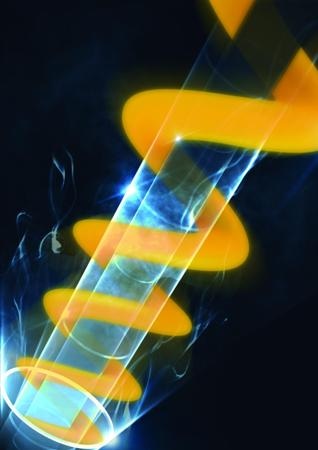Mar 17 2016
Nature Photonics today published research by a team from South Africa and Italy demonstrating a new type of laser that is able to produce laser beams 'with a twist' as its output. The outputs and superpositions of the new type of laser form a set of beams, called vector vortex beams. Using geometric phase inside lasers for the first time, the work opens the way to novel lasers for optical communication, laser machining and medicine.
 This is an artist's impression of spiral light created at source. Credit: Marko Mandusic
This is an artist's impression of spiral light created at source. Credit: Marko Mandusic
The idea was conceived by Prof. Andrew Forbes of the University of the Witwatersrand (Wits), who also led the collaboration while all the key experiments were performed by Dr Darryl Naidoo of the Council for Scientific and Industrial Research (CSIR). The team members of Prof. Stef Roux (Wits and the CSIR), Dr Angela Dudley (Wits and the CSIR) and Dr Igor Litvin (CSIR) all contributed significantly to the work. The custom geometric phase optics, without which the realisation of the idea would not be possible, were produced by the Italian team from the University of Naples, Prof. Lorenzo Marrucci and Prof. Bruno Piccirillo.
"We are all familiar with angular momentum in our everyday lives: the spinning Earth carries spin angular momentum while the orbiting Earth carries orbital angular momentum (OAM). Light can also carry angular momentum: through its polarisation (spin), and through its pattern and phase OAM," says Forbes.
Producing light with a controlled spin in a laser has been known for decades, but producing OAM beams inside a laser is not so simple. Light carrying OAM is created by twisting the phase of light into a helical shape, forming a spiral. Because the twisting of the pattern gets tighter and tighter as you move towards the centre of the beam, the light disappears and such beams are often called doughnut beams or vortex beams. The problem is that usually lasers cannot tell the difference between light that is twisted clockwise and light that is twisted anti-clockwise, and so the laser simply gives a combination of both in an uncontrolled manner. Moreover, combining spin and orbital components to produce general beams from a single laser that are mixtures of the two momenta, have not been demonstrated before.
"Our novelty was to realise that by using custom-geometric phase optics to map polarisation to OAM, the laser could be designed to tell the difference between the clockwise and anticlockwise light," says Forbes. The control is achieved by simply rotating a single optical element inside the laser, without any need for realignment. Such beams have been used in optical communication, optical trapping of microparticles and metrology - and now a single laser can create them on demand.
The geometric phase of light is a very abstract concept, first appearing in quantum theory, but here the researchers have used it to create particular types of twisted light. The custom optic, called a q-plate, changes the handedness of the OAM twist according to the handedness of the polarisation twist, mapping one to the other. For example, if clockwise polarised light with no twisted phase is passed through the optic, the output is anticlockwise polarised light with a clockwise twist in phase. By placing this element inside the laser, the twist in polarisation (spin) controlled the handedness of the twist in OAM, so the output could be controlled in either. "We like to call this a spiral laser because both the polarisation and OAM of the beam give rise to light that spins or twists in complicated ways," says Forbes.
Importantly, the same laser can produce any combination of these OAM beams and various polarisations of light. The team was able to show that the outcome was the generation of arbitrary vector vortex beams, known as higher-order Poincaré sphere beams. For example, in addition to the special cases of OAM beams, the same laser also produces radially and azimuthally polarised light, where the polarisation (direction of the electric field) changes in space. For example, radially polarised light has the field always pointing away from the centre of the circle, which is very useful for cutting and drilling metals. Such beams are often called 'vector' beams because the polarisation changes across the beam. When the polarisation pattern stays constant across the beam, it is called a 'scalar' beam. In the reported work, the researchers have shown that either can be created from the same laser.
"You have to understand that vector vortex laser beams have proven immensely useful in machining metals and other materials with lasers, for example, in the automotive industry. But until now we have not been able to produce all of them in one laser," says Naidoo, who performed the experiments as part of his doctoral studies and who is the lead author of the paper.
The laser concept is likely to attract interest from both the academic and industrial communities. Vector and scalar vortex beams that exist on the higher-order Poincaré sphere have many applications, such as microscopy, imaging, laser machining, and communication in free space and in fibres. Often one has to decide beforehand which beam is the most desirable and then design a laser for it. Now it is possible to have such beams available on demand from a single laser.